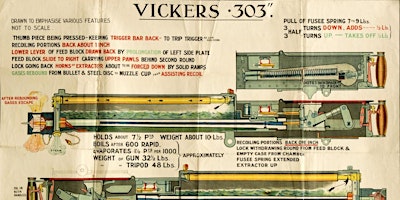Including pillboxes and turrets.
The Vickers was used in a variety of emplacements, depending on the particular role in which is was employed, the type of defence and the available ground. Those permanent fixtures are generally referred to as ‘pillboxes’.
Great War positions
Early development of ‘permanent’ positions varied little from the temporary positions in terms of the siting but the development and use of construction design and materials were the distinguishing features.
To ensure that the Vickers would function within any constructed pillbox or other fortification, and they would be built to the correct dimensions, scaled drawings with dimensions were provided to assist in construction. These covered the different mountings that were in use.
Second World War positions
The pillboxes of the Second World War were developed as part of specific location defences or stop lines. Those for the Vickers MG used both the standard Mark IV tripod and the Trench mountings. There was also the ‘Turnbull’ mounting used in a smaller loophole, which could mount the gun directly.
Whereas most pillboxes were assigned a numbered ‘Type’ reference, the MG ones were usually identified as ‘MG’ or ‘MMG’ Type, with occasional reference as Type DFW3/27. They were usually located in pairs, supporting the principle that guns in direct fire roles should never be employed with singly.
The standard Type 3/22 pillbox was a hexagonal pillbox with five loopholes and an entrance on the sixth face, sometimes shielded with a blast wall. These are the most common of all types of pillboxes were but designed for use with the Bren LMG and rifles only; however, an example in Hogsthorpe, Lincolnshire, has been found with a table for mounting the machine gun tripod on and an enlarged embrasure.
A variant of the hexagonal pillbox, shaped as a lozenge – with two long and four short sides – has also been found in the UK. An ‘eared’ example in Fraisthorpe, East Yorkshire, includes provision for two MMGs but no tables.
An example of frontal MMG defence, with provision for light anti-aircraft (LAA) fire using a Bren, has been found in Shoreham-on-Sea, West Sussex, and this accommodates three MMGs. Another box for three MMGs has been found in Builth Well, Powys, but has no LAA provision.
There was a type fitted for a pair of MMGs, firing in different directions (at 90 degrees to each other) so unable to support the others fire with ease. They had an internal wall and the requisite mounting tables. Examples have been seen in Suffolk and Kent.
A two-gun design is also found in Kingston-on-Spey, Moray, where the guns fire in opposite directions to use enfilade fire along a beach.
A large, four-gun, example is found in Southminster, Essex, which as a further seven loopholes for Bren and rifle positions. This appears to be three inter-linked pillboxes constructed as a single entity.
In Rye Harbour, Sussex, an example has been seen with loops and embrasures for six MMGs.














